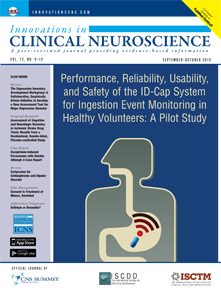 Dear Colleagues:
Dear Colleagues:
Welcome to the September-October 2016 issue of Innovations in Clinical Neuroscience (ICNS). As the official journal of the CNS Summit, the International Society for CNS Drug Development (ISCDD), and the International Society for CNS Clinical Trials and Methodology (ISCTM), an important part of our editorial mission is to accelerate and enhance the development of cheaper, more effective treatments for our patients through technology, collaboration, and innovation—not just in neuroscience but in all disciplines of medicine and among all involved entities, including clinicians, researchers, and members of industry. Building better clinical trials is crucial to developing better treatments, and in this issue of ICNS, we present examples of how technology, collaboration, and innovation can be used to improve two critical components of a successful clinical trial: patient adherence and symptom assessment. As practicing clinicians well know, adherence and assessment don’t stop with the clinical trial, so we hope clinicians and researchers alike will find value in the discoveries of this edition’s contributors.
We begin the issue with technology: In the article, “Performance, Reliability, Usability, and Safety of the ID-Cap System for Ingestion Event Monitoring in Healthy Volunteers: A Pilot Study,” Flores et al present the results of their study that evaluated an ingestible microsensor that is embedded in a medication capsule. Once activated by stomach fluid, this microsensor communicates digital messages to an external wearable reader to confirm ingestion. This was an open-label, single-arm, exploratory study. According to the investigators, positive detection accuracy was 100 percent for the directly observed ingestions of the study capsules, and of the 384 self-administered ingestion events that weren’t directly observed, 371 events were accurately detected, with an overall adherence of 97.75 percent (391 detections/400 expected ingestion events). The authors report no adverse events. While the investigators acknowledge that further studies will be needed to evaluate the usability of the system in clinical trials and in the clinical setting and evaluate its use in specific patient populations, they believe this technology has the potential to enhance clinical research and drug development, healthcare delivery, and healthcare outcomes by providing meaningful adherence data that may provide new insights into medication-taking behaviors.
Next, collaboration: Vaccarino et al describe the Depression Inventory Development (DiD) initiative of the ISCDD in their article “The Depression Inventory Development Workgroup: A Collaborative, Empirically Driven Initiative to Develop a New Assessment Tool for Major Depressive Disorder.” Here investigators sought to develop a comprehensive and psychometrically sound measurement tool to be utilized as a primary endpoint in clinical trials for major depressive disorder. The authors provide an overview of the DiD initiative, including results of the third iteration of items assessing symptoms related to anhedonia, cognition, fatigue, general malaise, motivation, anxiety, negative thinking, pain, and appetite. According to the authors, the strategies adopted from the DiD program have, as an empirically driven and collaborative process for scale development, provided the foundation to develop and validate measurement tools in other therapeutic areas as well.
Following this, innovation: Di Cesare et al describe their randomized, controlled clinical trial in the article “Assessment of Cognitive and Neurologic Recovery in Ischemic Stroke Drug Trials: Results from a Randomized, Double-blind, Placebo-controlled Study.” Here, the researchers sought to determine whether post-stroke recovery outcomes based on behavioral measures of cognitive and motor impairment yielded additional information beyond that of clinician-based methods. Their results support the validity of measures from Box and Blocks Test, Hand Grip Strength Test, 10-Meter Walk Test, and Repeatable Battery Assessment of Neuropsychological Status Coding Subtests to monitor post-stroke recovery in clinical trial settings. The investigators concluded that certain behavioral measures of cognitive and motor functions may extend the evaluation of the therapeutic potential of new treatments for stroke recovery. They also concluded, based on the lack of correlation between Recognition Memory Test and the traditional efficacy endpoints, that there may be cognitive elements not detected by the Modified Rankin Scale, and that memory improvement has potential as an endpoint in future trials aiming to improve certain aspects of cognition.
We continue the issue with some excellent articles our clinicians should find particularly informative. Pennington and Guina share an interesting case report titled, “Eszopiclone-induced Parasomnia with Suicide Attempt: A Case Report.” The authors report on a middle aged man who, two days after starting treatment with sertraline and eszopiclone for depression, experienced a severe episode of parasomnia during which he attempted to kill himself with a box cutter. The authors explore possible biochemical explanations for this behavior and examine the pharmacologic profile of eszopiclone and its potential for drug-drug interactions, especially with concomitant administration of monoaminergic medications such as antidepressants. This case report serves as an important reminder for us to carefully consider drug-drug interactions when prescribing medications to our patients.
Next, in a brief review article titled, “Cariprazine for Schizophrenia and Bipolar Disorder,” Scarff describes mechanisms of action, efficacy, tolerability (including adverse effects), dosing, and contraindications of the newly approved antipsychotic cariprazine.
Following this, McNary tackles questions from our readers in this month’s Risk Management column, “Consent to Treatment of Minors, Revisited.” She provides insight on issues such as how often a clinician should update a minor’s consent, treating minors in states where parental consent isn’t required for psychiatric treatment, how to handle consent of minors in situations of divorce, and more.
And finally, in this edition’s Differential Diagnosis, Lippmann and Perugula present a checklist of similarities and differences between delirium and dementia for use as a diagnostic aid.
We hope all of our readers enjoy this edition of ICNS. As always, we welcome thought-provoking feedback and innovative submissions.
Sincerely,
Amir Kalali, MD
Editor, Innovations in Clinical Neuroscience





